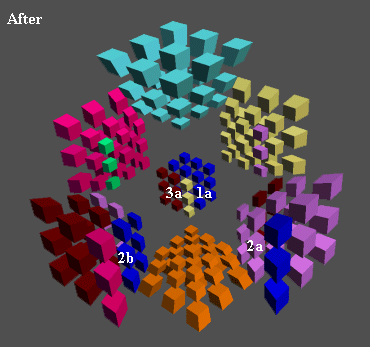Two-Color
Series
This is a four-move sequence that will shuffle around 3 two-colored pieces. It will also alter the position of some edge and corner pieces, but since we will be solving the faces before we worry about those pieces, that doesn?t matter.
Just as we did with the 3D cube, we are going pick three of the two-colored pieces we wish to manipulate. And just as we did with the 3D cube, we are going to label these pieces #1, #2, and #3 depending on how we want the pieces to move upon executing the sequence. The only difference here will be that it will take some practice to learn how the 4D twists work and become comfortable with them.
The sequence is the same.
| Turn One | #1 piece replaces #2 piece | |
| Turn Two | #3 piece replaces #1 piece (or the original #2 piece position) | |
| Turn Three | Reverse Twist One | |
| Turn Four | Reverse Twist Two |
The result is the same.
Piece #1 will be in the position originally occupied by piece #2.
Piece #2 will be in the position originally occupied by piece #3.
Piece #3 will be in the position originally occupied by Piece #1.
Piece?s #1 and #2 will not have inverted, but Piece #3 will have inverted. No other face piece positions or orientations will be altered.
I am going to do my best to show you the result of this sequence (and the others) graphically with screen shots. Where I can, I?ll label the piece positions, but often times portions of the pieces will be hidden.
Example before and after screen shots.
Piece #1 is Blue/Red.
Piece #2 is Blue/Purple.
Piece #3 is Red/Purple.


Some Helpful Hints:
-
You will be using the left and right mouse buttons to be doing clockwise and counterclockwise twists. Turns 3 and 4 of this series are just clicking on the same pieces of Turns 1 and 2 with the opposite mouse button.
-
Like I mentioned in Step 1, things will also remain simpler here if you execute this series by using ?face? twists only. Although you can apply the sequence with more complex twists, they are not required, and you won?t gain anything in efficiency.

